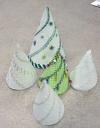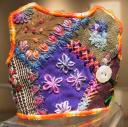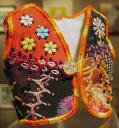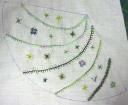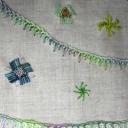Here is Miss Purple. She will be staying with my PPA at work (Marty is in charge of human resources at the Institute of Arctic Biology, where I work). I just got a raise and a new job title, which she was instrumental in helping me with, so I thought a little thank you gift was in order. She’s also helped so much with all the confusing UA paperwork in the past, and made sure I got paid (even though I almost always turn in my timesheet late!).
Her wings are some scraps left over from a friend’s quilting machine. I found tiny eyes that are glued on, and her buttons down the front are from a blouse found at the transfer station (garbage dump; there’s a recyclables section and I found the blouse there). Embroidery around the buttons and on the face is very simple; I used blanket stitch, french knots, and single chain on her dress. Blanket stitch edges her face, dress, and a very tight, close blanket stitch edges her wings. Cretan stitch holds down the blue yarn around her face.
Read more about the flat angel project here or select the category, Flat Angels, to see more of them.


